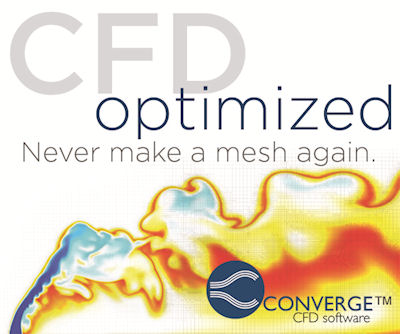Latest News
November 12, 2013
Years ago, I sat in a bar with a high school English teacher who was miserable with future shock. He’d received his first term paper printout, and was convinced a computer wrote the kid’s essay. Evidence: No erasure splotches, no smears from bunched up ribbon, no slanted text from misfed paper, and thoughts better organized. The devil in the details was that it sounded like the kid. The teacher could not process that word processing eliminated manual typewriter time wasters like feeding the paper correctly, rewinding the ribbon, or getting every letter, sentence, and paragraph right the first time every time. The writing process he knew was immutable.
 |
Difficulty assimilating that there are new ways of doing familiar things is something we all fall prey to. You may bump into some preconceived notions watching today’s Check it Out on-demand webinar “Eliminating Meshing from Gas Turbine and Burner CFD Simulations” from Convergent Science. While this webinar focuses on internal combustion, it seems that the company’s CONVERGE CFD (computational fluid dynamics) software is applicable to all sorts of engineering by folks who spend a lot time meshing before they deal with their complex geometries and flows.
But first, yes, eliminating meshing. You still have meshes in your life. But you do not have to spend days going through gyrations making a mesh or waiting for someone to do it for you before you can do your CFD study. That also means you do not lose all those flashes of insight that pop up and disappear while you’re humming someday my mesh may come.
The key here is that CONVERGE CFD code has what’s called Adaptive Mesh Refinement (AMR) technology. Basically, AMR automatically refines your mesh at run-time. (Yes, it’s fully customizable, so you stay in control.) AMR is said to increase accuracy and decrease run-times by using more mesh where it’s needed and less where you don’t need it.
Most of this 45-minute webinar is devoted to a pair of demos showing what this software can mean for you. The first demo kicks in at 6:30 or so after the usual who we are intro and client list (impressive list, BTW). The longer of the two, it looks at a liquid-fired aviation gas turbine application. The geometry includes mixer, atomizer, lining, and casing. Diffusion cooling holes are the focus. Make sure to go into full screen mode so that you can see the presenter’s cursor moving around as this and that are pointed out.
This is the demo that shows you what CONVERGE is about. It covers things like noteworthy tools and Ensight visualization features. It shows the process you’d go through to set up conditions, grids, and so forth. Some of the user features of CONVERGE also are highlighted, including diagnostics and repair tools. AMR is explained with lots of on-screen examples. Also covered is something called a Mechanism Reduction Utility that seems like it’ll shave off more time and effort.
The second demo looks at a supercritical jet in a crossflow. This is the “get a load of this” demo. It’s not long. It didn’t have to be since it shows that you can perform a fully coupled combustion and detailed chemistry study. Good stuff.
The webinar then runs through turbulence, discreet-phase, and other model types the software offers. A quick look at the software’s high-performance computing capabilities and a brief Q&A are given before they wrap it up.
This was the first time I had seen Convergent Science’s CONVERGE CFD tool in action. It’s impressive. Now, ask yourself: If your process suddenly went from import to set-up to solve without the delay making a mesh, how much time would be saved and put to use elsewhere? Not sure that you really can eliminate the meshing stage? Hit today’s Check It Out link, watch “Eliminating Meshing from Gas Turbine and Burner CFD Simulations,” and see for yourself.
Thanks, Pal. – Lockwood
Anthony J. Lockwood
Editor at Large, Desktop Engineering
Eliminating Meshing from Gas Turbine and Burner CFD Simulations
Subscribe to our FREE magazine, FREE email newsletters or both!
Latest News
About the Author
Anthony J. Lockwood is Digital Engineering’s founding editor. He is now retired. Contact him via [email protected].
Follow DE





